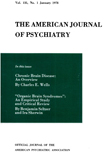PSYCHOSES ASSOCIATED WITH THE ADMINISTRATION OF ATABRINE
Abstract
1. Forty-three cases of psychosis associated with the administration of atabrine, 9 of them secondary to the massive treatment for malaria, and 34 following atabrine suppressive therapy, have been studied.
2. The reactions most frequently encountered were manic-like reactions, seen in 27 cases, while 15 schizophrenic-like reactions were seen. One depressive reaction was seen.
3. The reactions were characterized by an acute sudden explosive onset, a stormy course and a return to normal in a period of 30 to 35 days.
4. In an effort to determine the etiological relationship of atabrine in the study of the psychoses an atabrine factor was postulated, dividing the reactions into a primary and a trigger group. Thirty-four reactions occurred in the trigger group, whereas only 9 reactions occurred in the primary group.
5. It was found that the primary group displayed a true sensitivity to the drug, whereas in the trigger group a predisposed personality as well as emotional conflicts or acute illnesses were as great a factor as the atabrine itself.
6. Retesting with atabrine was performed in 20 cases; 13 being retested with the massive schedules 4 being retested on the suppressive schedule, and 3 being retested by the massive schedule followed by suppressive schedule. Of the 5 cases in the primary group, which were retested, all became psychotic; 3 being retested by massive therapy, I by massive and suppressive, and I by suppressive therapy. Of the 14 cases in the trigger group there were 4 failures; 2 of these received the suppressive r#{233}gimewhile 2 received the massive plus the suppressive régime, the rest receiving the massive rlégime.
7. Blood atabrine studies were not found to be a reliable aid in the diagnosis of a toxic psychosis due to atabrine.
8. Treatment in the toxic psychoses consists of withdrawal of the toxic agent, the maintenance of body nutrition and adequate sedation.
9. Of the 43 cases studied, 37 individuals (86 percent) were returned to duty,
10. Thirty of the 37 individuals returned to duty were given follow-up study for a period varying from 2 to 8 months. In this group there was not recurrence of the psychosis.
Access content
To read the fulltext, please use one of the options below to sign in or purchase access.- Personal login
- Institutional Login
- Sign in via OpenAthens
- Register for access
-
Please login/register if you wish to pair your device and check access availability.
Not a subscriber?
PsychiatryOnline subscription options offer access to the DSM-5 library, books, journals, CME, and patient resources. This all-in-one virtual library provides psychiatrists and mental health professionals with key resources for diagnosis, treatment, research, and professional development.
Need more help? PsychiatryOnline Customer Service may be reached by emailing [email protected] or by calling 800-368-5777 (in the U.S.) or 703-907-7322 (outside the U.S.).



